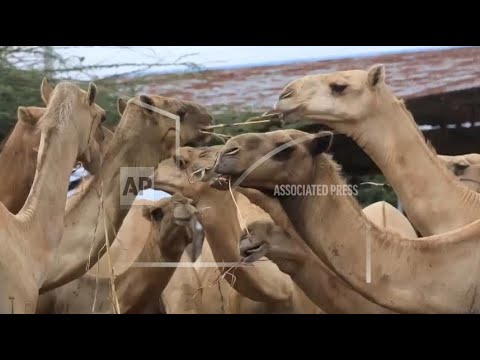(4 Aug 2025)
RESTRICTION SUMMARY:
ASSOCIATED PRESS
Mogadishu, Somalia – 18 June 2025
1. Wide of camels running
2. SOUNDBITE (Somali) Abdirisak Mire Hashi, veterinarian: ++STARTS ON SHOT 1 AND PARTIALLY OVERLAID BY SHOTS 3 TO 5++
"Somalis take pride in their heritage of raising camels. But the way camels are raised has changed significantly over time. In the past, families didn’t fully appreciate the value of camel milk. But today, both camel milk and meat production have been revolutionized and increased. Currently, each camel can produce ten liters of milk per day, compared to only five liters in the past."
3. Various of camel suckling
4. Various of camel being milked
5. Various of camel milk being poured into container
ASSOCIATED PRESS
Mogadishu, Somalia – 19 June 2025
6. SOUNDBITE (Somali) Dr. Yahye Sholle, Nutritionist: ++PARTIALLY OVERLAID BY SHOTS 7 TO 13++
"Camel milk yoghurt is rare around the world, yet it offers numerous health benefits. It is rich in magnesium and calcium, which support bone health. Additionally, it contains vitamins B12, C, and D. It also includes friendly bacteria known as probiotics, which are beneficial for gut health. Lastly, this yoghurt is lower in lactose, making it suitable for those who are lactose intolerant. Overall, consuming this yoghurt is highly beneficial."
ASSOCIATED PRESS
Mogadishu, Somalia – 18 June 2025
7. Close of milk being poured into processing tank
8. Mid of bio-engineer working in factory
9. Milk being processed into yoghurt
10. Mid of bio-engineer packing processed yoghurt
11. Close of tray of yoghurts
12. Close of bio-engineer tasting yoghurt
ASSOCIATED PRESS
Mogadishu, Somalia – 19 June 2025
13. Various of man buying camel yoghurt from supermarket
STORYLINE:
Camels have long been the backbone of Somalia’s pastoralist culture; feeding families, transporting goods and standing tall in local folklore.
But on the dusty outskirts of the capital, the camel now finds itself at the center of an agricultural revolution that could redefine Somali farming.
On a breezy Wednesday morning in mid-June, The Associated Press visited Beder Camel Farm — one of a new generation of camel dairies springing up around Mogadishu.
Dozens of camels sauntered around sandy paddocks while others nibbled on fresh fodder under the watchful eyes of herders.
In a nearby shed, workers carefully milked the animals and collected the frothy yield in sanitized containers.
Demand for camel milk is growing, buoyed by a wave of local entrepreneurs who see untapped potential in a traditional resource.
Somalia is home to over 7 million camels — more than any other country on Earth — but only a fraction of that milk has ever reached urban grocery shelves, according to industry estimates.
At the heart of the shift toward a modern approach to camel milk production is Dr. Abdirisak Mire Hashi, a veterinarian and the farm’s manager.
For Hashi, it’s not only about profit — it’s about preserving heritage while embracing progress.
“Somalis take pride in their heritage of raising camels. But the way camels are raised has changed significantly over time," Hashi said as he inspected a milking herd.
Each camel at Beder now produces up to 10 liters (2.6 gallons) of milk daily — double what traditional herders typically yield.
The increase is attributed to new investments in veterinary care, better feed, and modern milking practices.
The camels are routinely checked by vets, given nutritional supplements, and grazed on scientifically blended fodder, a far cry from the roaming nomadic herds of decades gone by.
Find out more about AP Archive: http://www.aparchive.com/HowWeWork
Twitter: https://twitter.com/AP_Archive
Facebook: https://www.facebook.com/APArchives
Instagram: https://www.instagram.com/APNews/
You can license this story through AP Archive: http://www.aparchive.com/metadata/youtube/f48b84a11535466d9919bde094c7686b
Author: AP Archive
Go to Source
News post in August 9, 2025, 3:05 am.
Visit Our Sponsor’s:
News Post In – News





